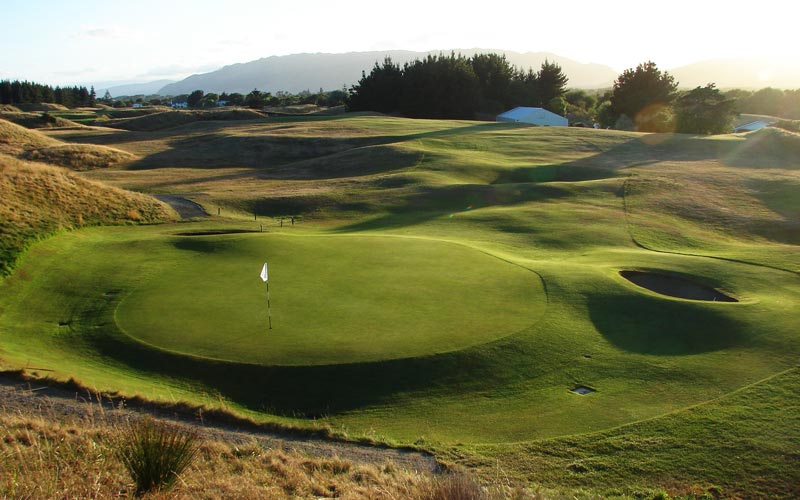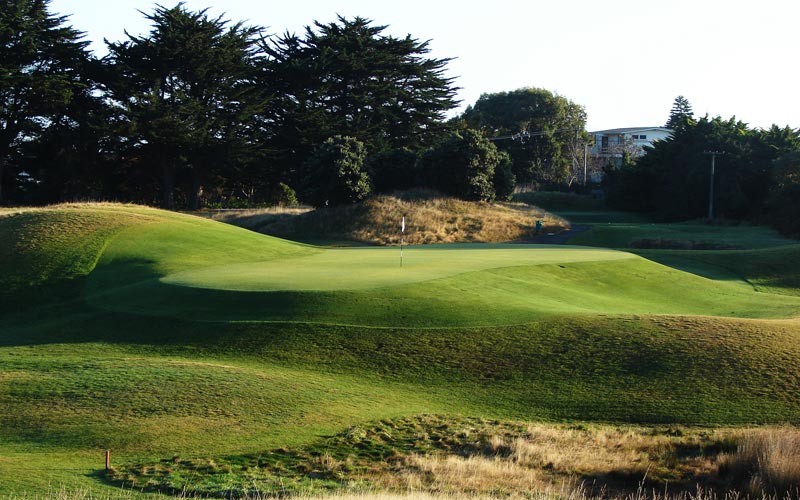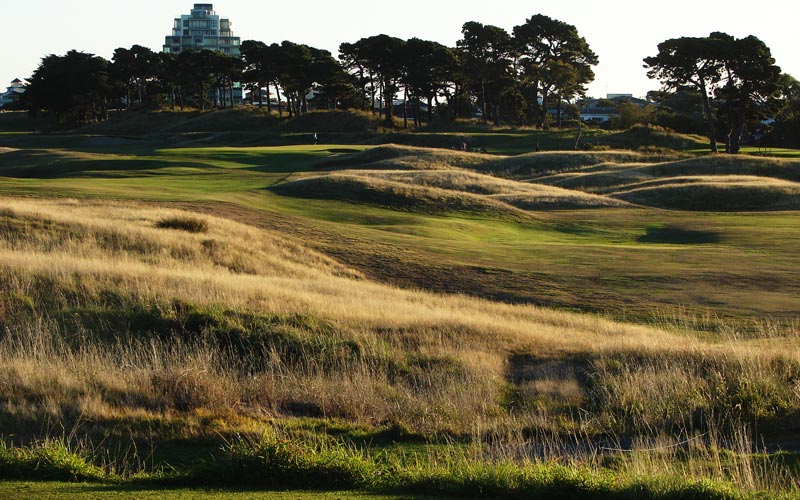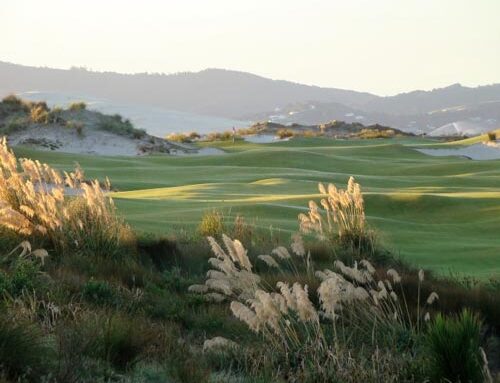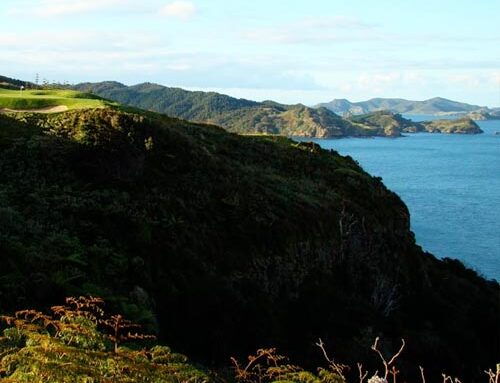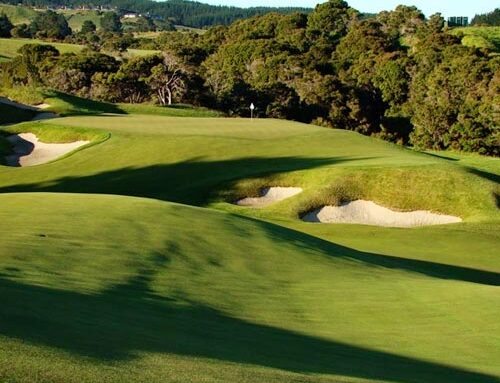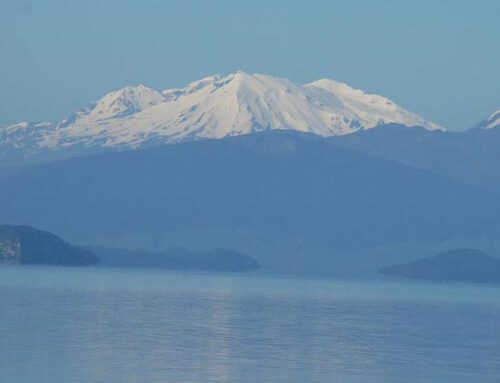Paraparaumu Beach Golf Club
Paraparaumu Beach, New Zealand
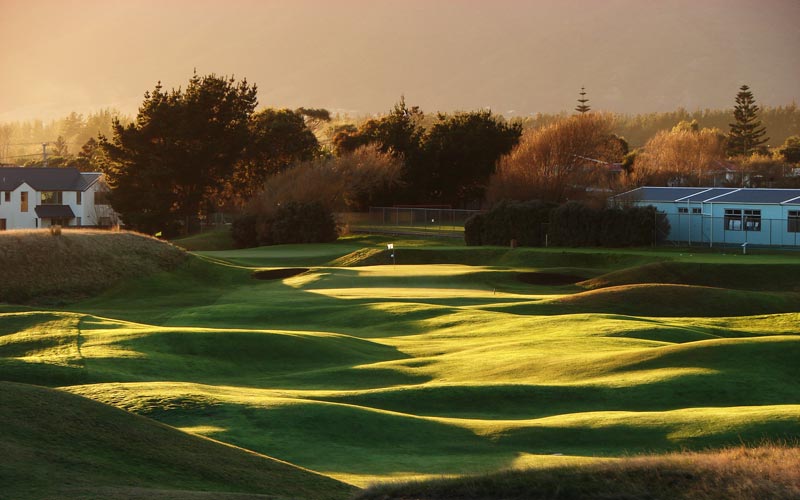
As seen from the sixth tee, the star at Paraparaumu Beach is its crumpled landscape. Any effort by man to replicate such random humps and bumps pales in comparison to what nature provided here.
Surprisingly, New Zealand has only a few world class courses for a country blessed with so many natural wonders that include miles of unspoiled coastline, clear blue lakes, snow-capped mountains, pockets of sandy soil and rolling valleys. Julian Robertson has helped change this in recent times by building the clifftop Kauri Cliffs and Cape Kidnappers. However, the first course to truly show off the country’s majestic qualities will always be Paraparaumu Beach.
Located one hour north of ‘windy’ Wellington, Paraparaumu was built in 1948 by Australian great Alex Russell. Having won the Australian Open in 1924, Russell was a talented player but his real impact on golf developed from the five weeks that he spent with Alister MacKenzie during the construction of the West Course at Royal Melbourne. Clearly a quick study, Russell completely grasped the strategic principles that MacKenzie espoused. After his experience with the Good Doctor, Russell went on to design Yarra Yarra in Melbourne’s famed sandbelt as well as Lake Karrinyup outside of Perth in Western Australia. Four years later he came full circle to build the East Course for Royal Melbourne. Unfortunately, world events interrupted Russell’s design career and his next course was here some sixteen years later along the Kapiti coast of New Zealand’s North Island.
Comparing and contrasting his most famous design in Australia (the East Course at Royal Melbourne) with his design in New Zealand is fascinating as the two couldn’t be more different. Royal Melbourne is built on a large scale with grand sweeping bunkers and large rolling greens. The opposite greets the golfer at Paraparaumu where only thirty-four bunkers were needed and green size averages of only 5,400 square feet (about 20% smaller than the ones at Royal Melbourne). These become elusive targets in the wind, especially given their tendency to slope away on their sides. Located less than 1/2 mile from the ocean, there is no flat third paddock at Paraparaumu Beach, that’s for sure! The random bumps, hollows and knobs could only be the work of Mother Nature and are a sure sign that the course is sand based. Certainly, heavy machinery rarely touched these magnificently lumpy fairways, which must be considered among the most ideal golfing grounds found anywhere in the world. With the land taking the ball every which way, Russell didn’t need fairway bunkers to give the holes their spice.
The manner in which he draped the fairways over this terrain is a how to lesson in routing. Some holes like the first and fourth are slung low and play between rows of dunes. Others like the thirteenth, fifteenth and seventeenth play up, over and around. One thing is for sure: Paraparaumu Beach is at its best when it plays fast and firm. Hence at 6,600 yards from the back markers, this course is never about length but more about guile and cunning. Russell built it at a time when shotmaking was the preferred way to determine the better golfer as opposed to merely who can bomb the ball the farthest.
Examples of this abound at the green areas where some beg for running approach shots (e.g. the first and fourth) while others are built up on shelves and require some sort of aerial approach (e.g. the second and thirteenth). The club’s responsibility is to provide firm and true playing surfaces that enable the player to consider all options in determining the best shot to play. As many of the photographs within this course profile demonstrate, the club has made tremendous strides in recent years to provide what may be the fastest day-in, day-out surfaces in the southern hemisphere. According to the Club’s General Manger Leo Barber:
Paraparaumu Beach has always been regarded as one of the finest examples of Links Golf anywhere in the Southern Hemisphere. Unfortunately it would be fair to say that during the latter stages of the last millennium and the early stages of the current one that the genius of Russell’s design was not always complimented by the agronomic characteristics befitting of the very best examples of Links Courses world wide. Often when courses/clubs go through these periods the simple reaction is to look for superficial fixes – create more length, build new bunkers, redesign some greens all the while neglecting the fundamental issues that led to the situation. It was certainly my brief upon accepting the role of Superintendent in 2006 to set about restoring those fundamentals and instigating practices that would recapture the essential elements of the very finest Links. The most vital step initially we undertook was to define the desired characteristics, identify the objectives in which to achieve these and gain the acknowledgment and understanding of the membership to provide firm surfaces that were characterised by the finer grasses and presented in a consistent manner befitting the clubs status. Paraparaumu is extremely unique for this part of the world and I guess is seldom understood by those that seek out the ideals of the some of the courses up the road or those beamed in on our television sets. In early 2006 we formed a Course Management Policy Document and this document provided the blueprint for how the course would be managed back to health and its links characteristics restored. Four years on and phase one is almost complete. The fescues and bents are thriving, the organic matter has been reduced significantly firming up the surfaces, undesirable vegetation has been stripped back revealing the majestic beauty of long forgotten dunes, short grass has been promoted, bunkers revetted, inputs reduced and most importantly the romance of the links has returned and the fundamentals have been embraced by those whom hold the course so dear.
Indeed, the club founders would be quite proud of how the course has evolved. Originally a nine hole course, it occupied much of the same property as today’s back nine and golf was been played there since 1929. The locals built it and then expanded it to eighteen holes before the outbreak of World War II. Following the war, Russell was called in from Australia to redesign the course. According to Mr. Barber’s study of a 1942 aerial, many of the existing general corridors were utilized by Russell. This is no surprise as the property’s rectangular nature dictates that a preponderance of holes run along its lengthy northeast/southwest axis. Almost all of the green sites were reworked by Russell and tees were added. Certainly, some of the best holes on the course like the eighth, thirteenth, fifteenth, sixteenth, and seventeenth holes are new and owe their creation entirely to Russell’s imagination.
Like his mentor Alister MacKenzie, Russell didn’t stay around for the course’s construction but had this to say during an on-site inspection in 1952: ‘It was with the greatest of pleasures that I found my ideas and suggestions translated exactly as I had conceived them. I believe the Club Captain and the Greenkeeper between them were responsible and wish to thank them for the excellent work they did. Any mistakes in the layout and construction are all mine but I don’t believe there are and I do believe that when the fairways and greens mature, the course will rank as one of the best in New Zealand and, in fact, anywhere in the world.’
This was just the start of the acclaim which would be heaped upon this true links. The fact that it has hosted the New Zealand Open a record twelve times speaks to its playing merits. Here are the words of the great links player Peter Thomson. Borrowed from Paraparaumu Beach’s own web site, the five time Open winner gushes:
“I loved it instantly. We had nothing like it in Australia , which must have struck Alex Russell, who did the layout. Course designing approaches an art form, especially done in a perfect modelling medium like volcanic sand. Russell must have been ecstatic. What was left after his departure was a gem of enjoyment, a monument to the game and a gift to the future. When we all turn to dust, “Paraparaumu” the golf, should be still lying there as it was when the first golfers came by, with Kapiti an off-shore island standing guard to see that no one steals it away. And the winds will ever blow to test the golfer’s will and integrity. Paraparaumu will be famed for a century yet.”

To justify the trek to Paraparaumu Beach, golfers need to know that they will see things that they otherwise haven’t. Holes like the bunkerless par three fifth assure them that they won’t leave disappointed. Indeed, the natives chuckle that this is the first island green.
Apart from its attributes as a course, Paraparaumu is an important design because of its position in the evolution of golf course architecture. Russell started work here the same year that Donald Ross passed away. Other luminaries soon passed as well including Harry Colt, Hugh Alison, Stanley Thompson, and Perry Maxwell. There was a changing of the guard but unfortunately, the designs that followed the one at Paraparaumu Beach were inferior for several decades. Technically, Paraparaumu falls outside the Golden Age of golf course design but all of the Golden Age design tenets were successfully embraced here. Pity that its remote location hindered the new breed of architects from studying it and being reminded as to what is important (capturing varied landforms within the holes, interesting green complexes) and what isn’t (plush turf, bunkers used for decorative purposes off on sides of holes).
Holes to Note
First hole, 405 yards; At the turn of the twentieth century, the great majority of holes tended to run in a straight line. Not until the Golden Age of architecture was the concept of bending playing corridors widely accepted as a means of introducing strategy. Especially in windy locations, the benefits of curving fairways is fully realized as the player is challenged to frequently recalculate the type shot required in a shifting wind (subtle or otherwise). Appreciating that, Russell’s doglegs at the first, eighth and seventeenth add immeasurably to the overall variety of shotmaking required by the course. Unlike his predecessors, Russell had access to heavy machinery. In the hands of someone less skilled, this could have been a disaster but Russell used it sparingly and to good effect. For instance, the first fairway is an example where he successfully utilized it to help him snuggle a bending fairway low through the dunes.

The muted ripples in the ground indicate one of the few times that Russell elected to employ heavy machinery. As it is the first, Russell kindly lets the golfer hit the day’s first approach from a relative level stance.
Second hole, 205 yards; ‘Less is more’ is a widely understood design philosophy that was coined by building architect Ludwig Mies van der Rohe. Unfortunately, not enough modern golf course architects seem to appreciate his sensibilities as much as Golden Age architects. Take Russell’s work at the second where the general impression is that he smoothed over a dune for a tee and rounded off the top of another some 200 yards away and presto, a hole was born. Of course, there was more to it but the air of easy sophistication emitted by this hole and the course in general is one of the major reasons for Paraparaumu’s enduring appeal. Modern architects talk about working with nature but for a real life example, one is well served by coming here and seeing how the architect stayed in the background.
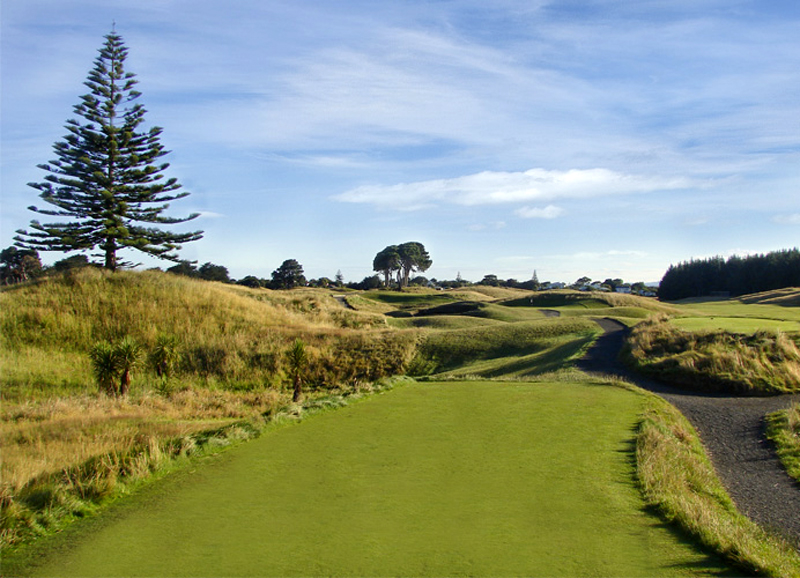
One of the strengths of a Russell design is its set of one shooters and that certainly holds true at Paraparaumu. As a sign of the ongoing good work by the club, the walking path as seen in the photograph above has been re-routed out of view.
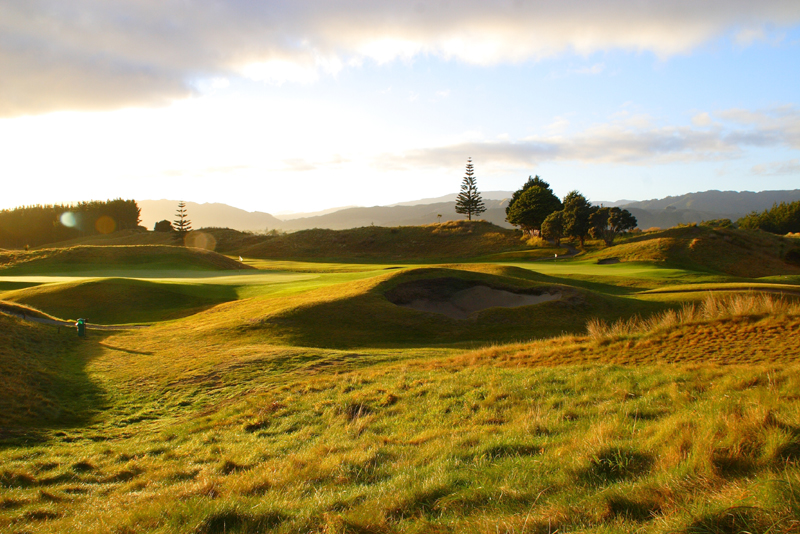
Some of the hazards like this one twenty yards short of the second green are more pits than bunkers, making recovery quite difficult. Others are even smaller in size, leaving little room for a grumpy golfer, his ball and a cramped swing.
Fourth hole, 450 yards; While the third and fourth measure a similar length, they couldn’t play more differently because they head in opposite directions. Given a prevailing northerly, the third will be tough slog into the wind and the fourth is the round’s first hole downwind. Set at a 45 degree angle to the fairway, the green begs for a cut shot with the golfer needing not to let his right hand come over top of his left during his follow through. This is no doubt an example where Russell’s skill as a player helped shaped his design process as all good players relish the ability to show off their full arsenal of shots.
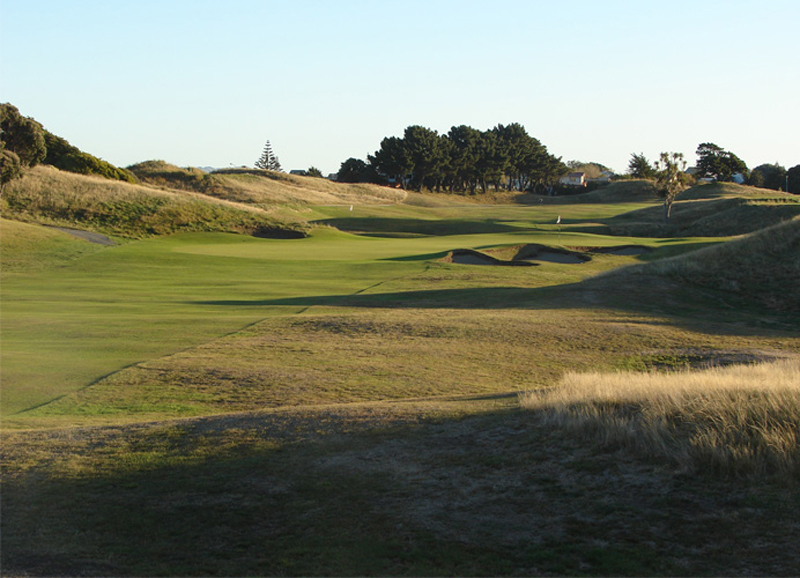
The approach into the angled fourth green requires some sort of a fade with the hard firm ground bringing back the art of shotmaking. On a real windy day, the player might try to land his approach as far short as thirty yards from the green’s front edge. This is true links golf!
Fifth hole, 160 yards; The first of two bunkerless one shotters (both superb, by the way) , Russell built up this pulpit green from its surrounds. The different slopes and grasses that envelope the green complex leave a wide variety of recovery shots, some of which are blind. Leaving it bunkerless demonstrates Russell’s practical nature and Paraparaumu can be playable very soon after a summer storm passes. Indeed, given its sandy soil, the course presents fine playing conditions year around. One can’t help but think/wince of the many modern designs with their plethora of bunkers that are maintenance nightmares, especially after storms. Not here!

As seen from behind the fifth green, a sense of relief sweeps over the golfer when he sees his tee ball come to rest on the plateau putting surface. Otherwise, his recovery shot might be from below eye level of the green.
Sixth hole, 325 yards; In some ways, advances in technology are the archnemesis of a course like Paraparaumu whose property is hemmed in on all sides. It simply doesn’t have the ability to expand to 7,000 yards like other courses that were built sixty years ago. However, here is an example where technology has made a hole more interesting/fiendish. Rare were the days in Russell’s time when a golfer could realistically think of driving this green but now from its elevated tee, many a tiger golfer is tempted to have a go, save for those days when the wind against is too much. While having a mighty slash is great fun, the player who gets off to either side of this long but narrow green will quickly discover that the angles of play have very much shifted against a potential birdie.
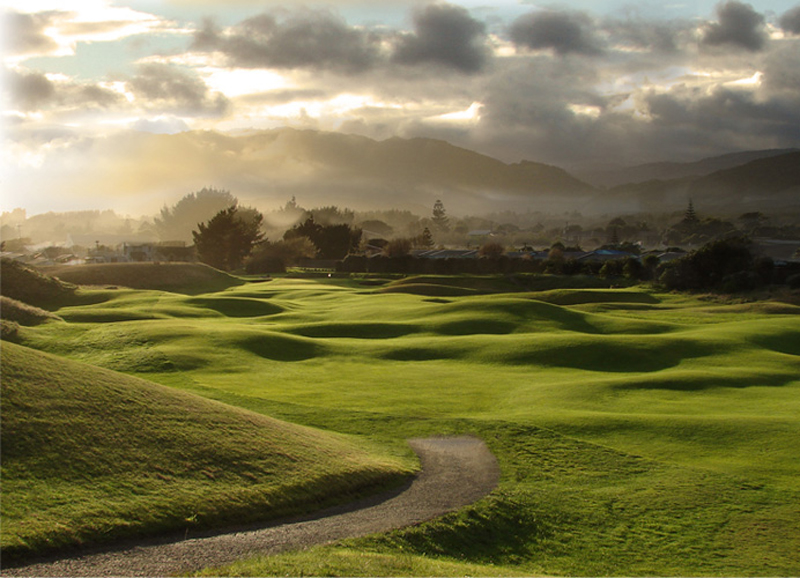
With the wind behind, the tiger may well be able to reach the sixth green in one blow from the tee. The rest of us are left to deal with the random landforms so perfectly captured by Russell within the fairway.
Eighth hole, 375 yards; At perhaps the quintessential hole at Paraparaumu, a driver isn’t a necessity as much as finding the fairway which bends left to right. The temptation is to cut off too much of this dogleg but hitting to this tiny pushed up green is problematic out of the fescue rough as the golfer can’t obtain any spin. At 3,450 square feet, the eighth green is the smallest target on the course and it plays even smaller as it slopes away on all sides. Though modest in length, old timers advise hitting for the center of the green and being content with a fifteen to twenty foot birdie putt. As with so many holes here, greed and/or rash tactics can kill.
Eleventh hole, 430 yards; Great architects like Russell used everything at their disposal for the sake of creating diverse challenge. At the tee, the threat of out of bounds down the left can unsettle the golfer. Still, he doesn’t have much option but to go with driver as he needs to cover a substantial distance in two blows. Yet, Russell angled the long, narrow green among dunes and then bunkered as to best accept shots played from the left portion of the fairway. A fundamentally sound risk/reward hole of the sort that one never tires of playing.
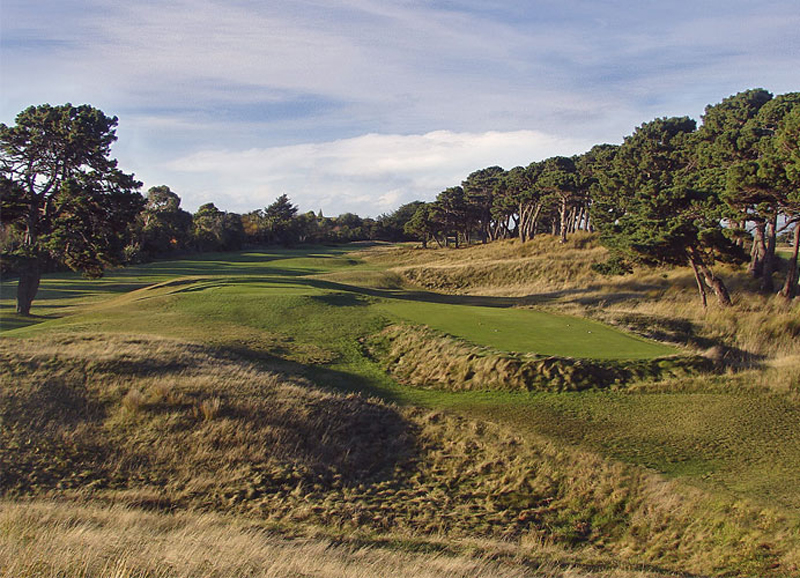
Here at the eleventh, out of bounds is hard down the left but the entrance to the green is also best had from the left portion of the fairway.
Thirteenth hole, 450 yards; A massive par four played up and down over rollicking terrain, the thirteenth is the most photographed hole in New Zealand and one of the most photographed in the southern hemisphere in part because the Tararua Range form such a handsome backdrop. As the Pacific Ocean is never quite in view from the course, this range serves as the dominant background. In some ways, that works in the course’s favor as the towering landforms are unique, lending another point of distinction to this links. In regards to the hole itself, the author had an interesting experience with its rambunctious terrain. On the same calm day, his morning drive deadened by an upslope, and was shunted sideways leaving a blind three wood approach. In the afternoon however, his tee ball fortuitously carried the crest and took off like a shot, happily bounding down the crispy fairway and only a nine iron remained. As the golfing gods would have it, and highlighting the unpredictable nature of links golf, he birdied the hole with the three wood approach! Russell knew when to leave well enough alone and with land like this, he saw no need for any bunkers. Though it has some outstanding rivals, it may well be the world’s best bunkerless hole.
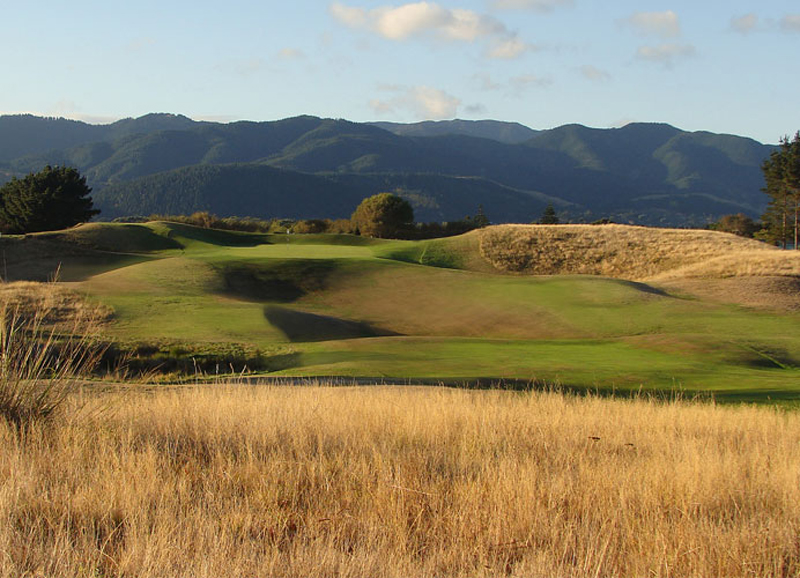
As seen in the summer, the burnt fairway is a links lover’s dream. Note how Russell bowled out an area for the putting surface.
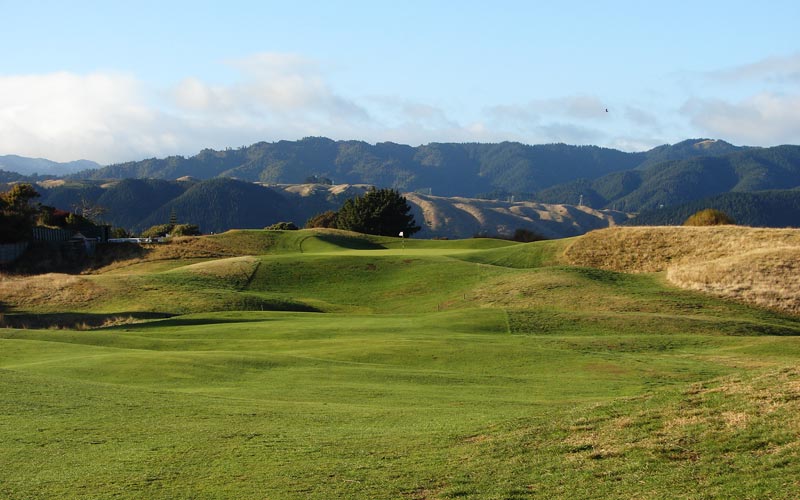
A mighty hole, the thirteenth is one of the reasons that Paraparaumu Beach has justly appeared many times on GOLF Magazine’s World Top 100 ranking.
Sixteenth hole, 140 yards; Seemingly separated at birth from the infamous Postage Stamp at Royal Troon, the sixteenth features the identical landforms as that feared one shotter in Scotland: A large dune to the left, a long, slender shelf for a green, and then a sharp drop off to the right. The only difference is that Russell opted to let the short grass act as a hazard as opposed to the five bunkers that ring the green at Troon.
Seventeenth hole, 445 yards; Despite its remote setting, many golfers make the effort to play this course, so compelling is the quality of its holes. It features truly great holes of the sort that any course that hosts the Open Championship in Great Britain would be delighted to claim as their own. The alternate fairway seventeenth is one such hole. Some elect to take the short route down the right but that requires an all or nothing carry over dunes and two greenside bunkers to reach the green. Others elect to play out left from the tee to create an easier, more open approach that plays down the length of the green.
No mention is made of the three par fives (the seventh, twelfth, and eighteenth) as they are the course’s only relatively undistinguished holes. Russell used the long three shotters as a means to chew quickly past the only uninteresting bits of the property. Nonetheless, good golfers trying to force the issue on these holes will find that they have a characteristic Russell bite for those with poor course management skills. Be it the gunch to the left of the seventh or the seven bunkers on the Home hole, the golfer needs to stay in position at all time at Paraparaumu.
Just how good was Russell as an architect? Any list of the top twenty-five courses in Australia and New Zealand would feature all five of the designs in which he was involved. Simply put, here is a man responsible in good measure for almost 25% of the best courses in this golf rich region of the world. The other southern hemisphere golfing giants South Africa and Argentina don’t have a course as good as Paraparaumu.
Just how good was the property that Russell was given? Virtually ideal, especially for those who love to see baked fairways and the ball being slung along the ground as this brand of golf harkens back to the game’s very roots and core. Ultimately, great golf is always about how the ball interacts with the ground, which is exactly this course’s strength. No doubt Alister MacKenzie would have been impressed by his star pupil’s accomplishment and indeed the Good Doctor might even be surprised that Russell’s work surpassed his own seven hours up the road at Titirangi!


